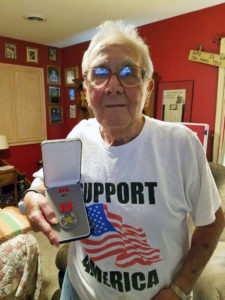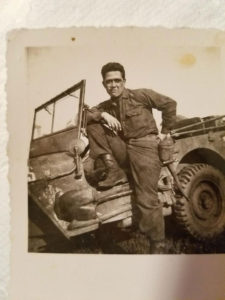James Rada, Jr.
Harry English put his life on the line just to join the U.S. Army, and because he did, many other men survived World War II.
English, a Hagerstown native, liked to spend his summers by himself on a small island in the Potomac River.
“All I had was a knife, a hatchet, and a .22,” he said. He would take some produce from a nearby farmer’s farm, with the farmer’s permission, and he would fish.
When war broke out, English knew it was his patriotic duty to join the military. He and a friend rode with English’s father to Baltimore when English was only eighteen.
English went to enlist in the Merchant Marines. During the physical, the doctor had him jump up and down. Then the doctor listened to his heart.
“He told me to lay down and lay still until my father came,” English said. “He said I had a bad heart and excitement would kill me.”
He thought that was a bunch of bunk and tried enlisting in the Army, Navy, and Coast Guard. They all turned him down because he supposedly had a bad heart.
With no other choice, English returned to school only to receive a draft notice in April 1944. He reported to Camp Meade, thinking that he would just be sent home. Instead, he became a soldier.
“They never said a word about my problem,” said English.
He went through sixteen weeks of infiltration training in South Carolina, and was then sent to Camp McCoy in Wisconsin. A doctor at the camp discovered English’s supposed heart condition and wanted to give him a discharge. “I told him, ‘The Army trained me, and the government spent a lot of money on me. My unit needs me. What difference does it make whether I die here or over there?’”
His argument was convincing, and he was sent to fight in Europe.
For the next two years, he traveled with Gen. George Patton’s Army and fought the Germans in the Battle of Bulge, as well as other battles. He drove Jeeps and cooked for his unit. He chauffeured the soldiers who were tasked with setting up the telephone communications.
During one battle, English volunteered to go into enemy territory with a chaplain to pick up wounded prisoners, no matter which side they fought on. He didn’t see it as doing anything special, but the chaplain put in for him to receive a medal for his actions.
He never received it because his unit moved around so much. He didn’t even realize he had been recommended for commendation.
He said his scariest moment in the war was when he realized that someone was shooting at him with a 20-mm gun. One shell flattened the spare tire on his Jeep, and shrapnel raked across his knuckles.
“I just kept thinking, ‘Man, that was close,’” recalled English.
By the time the American crossed the Rhine River in Germany, it was obvious the war was over, although there was no official word. German soldiers were laying down their weapons and surrendering.
Even after the war had ended, English stayed on to the help with the Nuremberg Trials. He drove vehicles for officers and lawyers. He heard parts of the trials that were broadcasted, and he saw Hermann Goering being led in for his trial.
Throughout the war, his heart never gave him any trouble.
Once he came home, English went on with his life. He married and worked thirty-seven years on the railroad. After his retirement, he and his wife moved to Florida, but later returned because they wanted to be able to watch their grandchildren and great-grandchildren grow up. English now lives in Sabillasville with his granddaughter Ann Seiss and her family.
Having earned it seventy-four years earlier, he finally received his Bronze Star Medal in July 2018 during a special ceremony at the Thurmont AMVETS. Maryland U.S. Rep. Jamie Raskin pinned the medal on English’s sports coat.
It was a long overdue honor for the ninety-two-year-old Veteran, and one that he was able to share with his family and fellow Veterans.

Harry English is shown with his Bronze Star Medal in July.

Harry is pictured with his Jeep during WWII.

